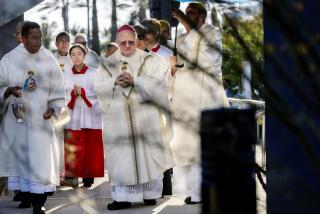Psychiatrist Testifies for Sect About ‘True Believers’
- Share via
A Westlake Village man who sued his former church for $253 million was a “true believer” who may have undertaken a “passionate vendetta” against the sect that once sustained, then disdained him, a psychiatrist testified Tuesday in Los Angeles Superior Court.
Superhuman Qualities
Psychiatrist Saul V. Levine said that Gregory Mull, 64, behaved like a true believer in at first endowing Elizabeth Clare Prophet, the 46-year-old “Guru Ma” of the Church Universal and Triumphant, with superhuman qualities and then becoming disenchanted with the spiritual leader and her Calabasas-based sect.
“Before Mr. Mull became disillusioned, there was total adulation of Elizabeth Clare Prophet,” said Levine. He said he had studied more than 400 people who joined “new-age” religions or cults. When the fanatical devotees that he calls “true believers” are forced out of their chosen groups, they may become “anti-cult cultists,” he said.
Asked to Leave Estate
Mull, formerly the sect’s resident architect, was asked to leave Camelot, as its Calabasas estate is called, six years ago, after a disagreement about money. The church later sued Mull for about $30,000 it says it loaned him. Mull claims that the money was owed him for expenses. He countersued, alleging that Prophet and other church leaders had defrauded him and caused him permanent emotional harm.
Levine, who is on the staff of the University of Toronto, Ontario, appeared as a witness for the church. Church Universal and Triumphant teaches that Prophet is a divinely inspired messenger who receives “dictations” from “ascended masters” including Jesus, Buddha and her late husband, Mark L. Prophet, who founded the sect in 1958.
Levine, referring to conversions to all-consuming religions and other groups as “radical departures,” said he eschews the term “cult” as pejorative.
“ ‘Cult’ is a four-letter word,” said Levine. He pointed to similarities between so-called cults and less controversial institutions, such as Orthodox Jewish yeshivas or seminaries, that also have overriding ideologies and strict rules. These similarities include wariness of outsiders and a “payoff” for members of the group, he said.
Painful Re-Entry Period
In his experience, he testified, cult members do not have more psychiatric problems than the public at large. He said that ex-members often experience a painful re-entry period of about six months. He knew of no one who had been permanently damaged by membership in a cult, he testified.
“Cults are in the eye of the beholder,” Levine elaborated in an interview. “What is my positive, supportive religion may be your cult.”
However restrictive the group looks to outsiders, its members typically get a positive reward, or payoff, Levine said. “What they get, in a nutshell, is a belief system, a sense of belonging and enhanced self-esteem,” he said.
“They’re full of emotional and social hunger, and if you feed that hunger, they’re satisfied,” he said. There are destructive cults, he said, declining to single any out. But, he added, “there are some very loving groups that are called cults.”
Unlike other group members, true believers develop a kind of tunnel vision, in Levine’s view.
‘Passionately Committed’
“A true believer takes that belief system and takes the group that adheres to it and becomes so passionately committed to that ideology and group that nothing else matters,” he said. “He becomes a proselytizer for a cause. . . . Everything is superseded by the ideology and the group.”
True believers lose perspective, he said. They are unable to think critically about the group or to consider perspectives other than those of their faith. “That’s all they want to talk about,” he said. “You want to kick them.”
Such blind faith almost always ends, Levine said. “They become disillusioned,” he said. “The idealization turns into disappointment, and they leave.”
More to Read
Sign up for Essential California
The most important California stories and recommendations in your inbox every morning.
You may occasionally receive promotional content from the Los Angeles Times.













